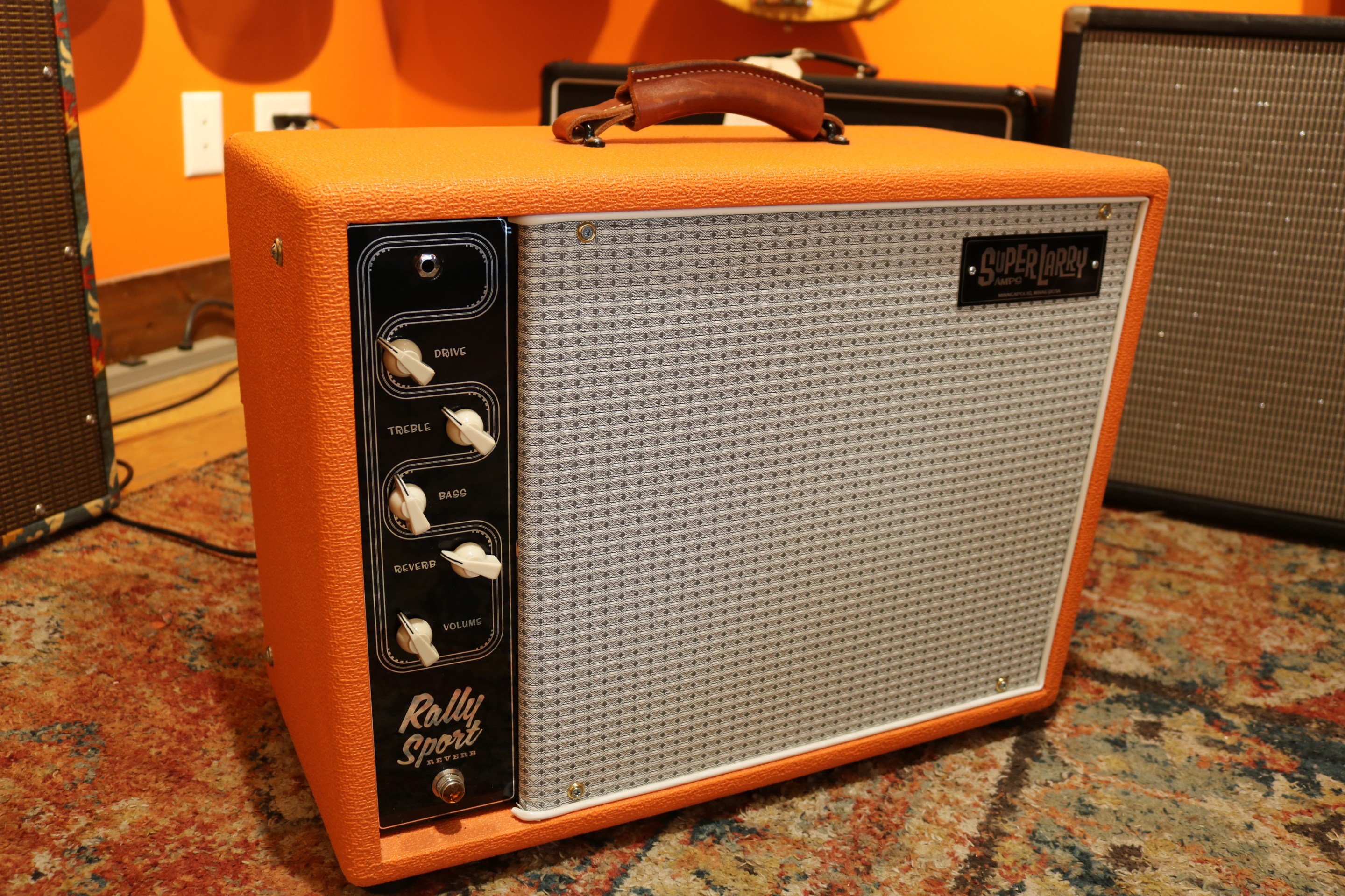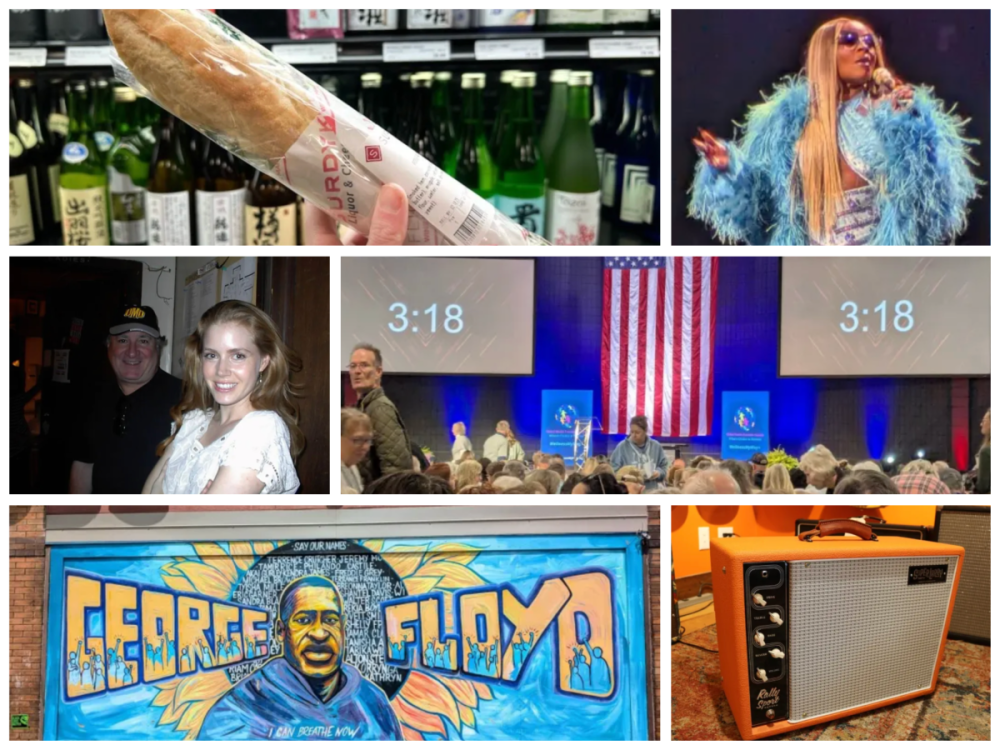Let’s talk about the most important piece of furniture in your home: Your vacuum tube guitar amplifier.
If you don’t play guitar, you may only picture amps as stacked black behemoths hulking behind classic rock legends onstage. But they come in all shapes and colors and sizes. (OK, mostly just the one shape.) And you can even get one made locally, by hand. Local, artisanal… high-voltage electronics? That’s right!
“You Can’t Really Buy Food With Poetry”: ToneTron Amps
Jeffrey Falla, the man behind ToneTron Amps in Minneapolis, once led a double life as an amp tech and scholar.
“It boiled down to, I really am into writing poetry,” says Falla, an amp builder and repair technician with a doctorate in comp lit. “I won some contests, and so with that I got some scholarships, and so it’s like, ‘Well, I guess I’ve got to do this now’... I got kind of lulled into that and just being an academic.”
But Falla shifted into amp building and repair full-time around 2013, bolstered by a positive review of a ToneTron Billy Rocker amp in Vintage Guitar magazine.
“I still write a lot of poetry. That’s still very dear to my heart,” he says. “But you can’t really buy food with poetry.”
When he started playing electric guitar in his early teens, Falla didn’t have an amp, so he'd plug into the family's home stereo. This pushed him toward electronic experimentation: He dumpster-dove for stereo equipment to tinker with and gradually developed an understanding of how amps worked.
At 18, Falla joined the Marines and received electronics training working on military equipment—“communication, navigation, radar, you name it.” After leaving service, Falla worked repairing and restoring video games and jukeboxes.
This was when he first tried building an amp, largely out of curiosity—a solid state amp he describes as “basically a Randall clone.” (Randall amps are most associated with “Dimebag” Darrell Abbott of Pantera.)
As he kept playing in bands, Falla began repairing other musicians’ equipment and, eventually, building and selling amps at cost. Dissatisfaction with a Fender amp he was using in a rockabilly band led him to his first original designs.
Demand increased over time, and Falla started ToneTron around 2005. The name was inspired by a box of “Fusetron” fuses he was using while doing a repair, and came about partly through customer demand.
“People would ask me, ‘What can we call your amp?’” Falla says. “I’d give them an amp that was a generic amp, and they’d want to have a name on it.”
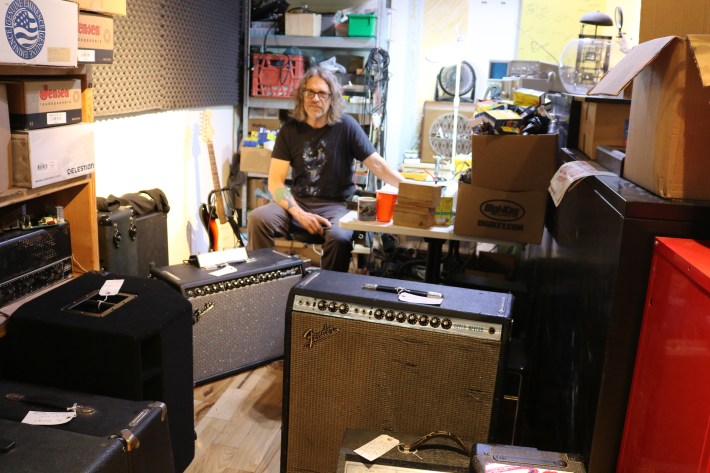
ToneTron customers can choose from a number of Falla's original designs or request a custom job, whether a replica of a vintage circuit or something they dreamed up—as long as it’s technically feasible.
“There’s a limit to what you can make,” Falla says, “or you’ll have three different amps.”
Looking Good, Sounding Good: Super Larry Amps
Another local amp maker is Super Larry Amps, founded by Laurance Anderson, whose amp designs are charmingly retro.
Anderson exudes quiet but intense enthusiasm for his amps and all things guitar—he’s so quiet he manages to slip into Spyhouse Coffee in northeast Minneapolis for our interview literally carrying an amplifier chassis without me noticing—even though I was facing the door. His designs reference mid-century modern aesthetics, and they often look beamed in from some alternate reality of the early 1960s.
“I’ve always felt that guitar amps need to sound great, but they need to look great too,” Anderson says. “I’ve always wanted to design an amp that people want to plug into, they want to play, an amp that looks great in your living room.”
Super Larry’s most recent run of amps is a model called the Rally Sport Reverb, a scaled-up version of the first design Anderson brought to market, the Super Sport. Both designs take after vintage Fenders, which means they offer bold, clear clean tones, surf-y reverb, and a ragged, bluesy overdrive.
As a guitarist, Anderson doesn’t use a lot of external effects, so he aims to design amps that sound great with just a guitar plugged in. Both amps feature a graphic of a race track on the control plate—a zig-zag track around the knobs for the Rally Sport and an oval track complete with pit stop (!) next to the reverb knob for the Super Sport—as well as a slightly asymmetrical speaker cabinet design, slanted on one side.
“It’s just slightly slanted,” Anderson says of the cabinet, “about a 10 degree slant on both the Super Sport and Rally Sport cabinets. The theme is, it’s like a hot-rodded car. It’s the feeling of movement.”
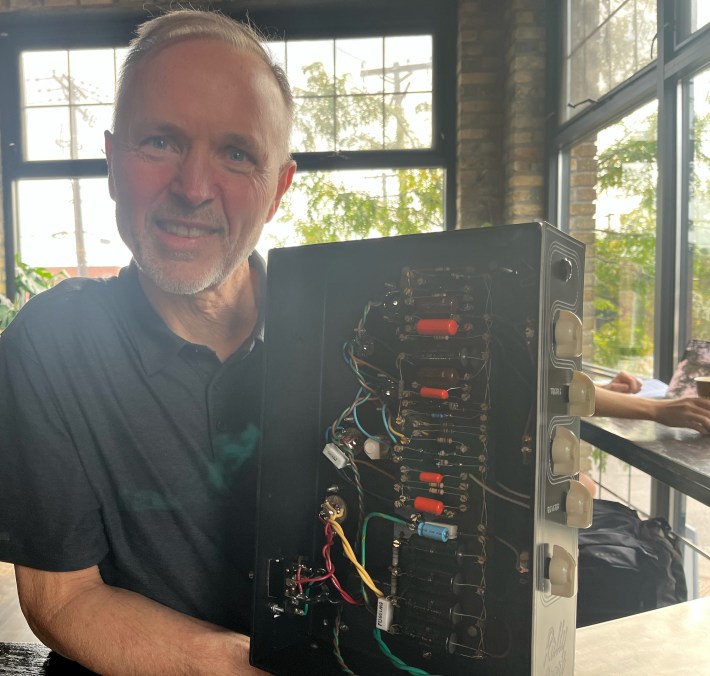
Anderson has a knack for model names: Previous Super Larry builds include the “Super Chump” and the “High Plains Riffter,” the latter of which sports a speaker cabinet elevated on short legs—both another nod to mid-century modern design and an elegant way to project the amp’s sound onstage without setting the speaker cabinet on a chair.
Anderson started experimenting with amp modification in high school, modding a solid state Vox amp head and cab into one combo unit. He kept going from there, developing amp design knowledge through tube amp-focused online forums. He struck up a long distance friendship with another builder and forum user, Mike Knauf of VT Amps, who became Anderson’s “amp mentor”; they collaborated back and forth on each other’s designs.
Anderson has a design background from working in the restaurant industry, originally as a designer of commercial kitchens, now working more in manufacturing. He credits his day job with making it a little easier to turn Super Larry Amps into a business.
“It’s one thing to build an amp,” Anderson said, “but if you can’t sell it, then you just have a basement full of amps.”
For Super Larry, Anderson collaborates with several other local businesses across the metro for the fabrication of cabinets, chassis, and leather handles of his amps.
“On the nameplate of my Super Larry Amps, it says ‘Made in Minneapolis,’” Anderson noted. “I’ve always felt a connection to Minnesota, and proud that we produced Bob Dylan, Prince, the Replacements. For me it’s been important to produce something here.”
"Tube Amps Are Human-Sized": Where and Why to Buy From the Little Guy
Jeffrey Falla offers amp repair service through El Diablo Amps and Guitars in Seward, which also stocks both ToneTron and Super Larry Amps. In addition to selling local-built amps, El Diablo has established a niche as the local source for small, craft-focused brands like Benson, Swart, and Milkman Sound.
For El Diablo owner Alan Estévez, stocking local amp builders felt like a natural choice.
“I always thought that it’s good to celebrate our own," Estévez says. "We have amazing builders, why not have a shop where they can have their amps in?”
Amps from some of the more nationally known brands El Diablo sells often cost two or three thousand dollars. Super Larry Amps are priced pretty competitively with these, while ToneTron amps are slightly more modest.
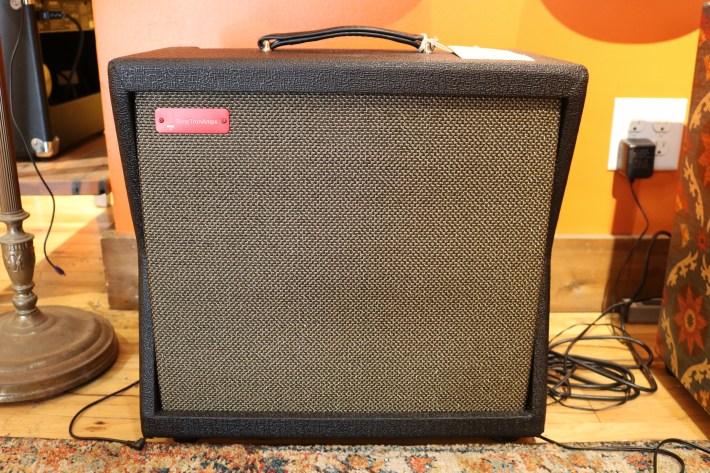
“My mission has always been to try to make them as affordable [as possible] for musicians,” Falla says. “I still price them usually below most boutique amps… That’s kind of a double-edged sword, because people say, ‘Well, if that one’s cheaper, it must not be as good.’”
Falla keeps prices down by doing most of the work himself. He builds his own cabinets and punches his own amplifier chassis. He occasionally silk screens his own control plates.
Building cabinets allows Falla to experiment somewhat freely with cabinet designs, although he stresses you can only go so far with the basic shape of a speaker cabinet and still have the product sound good. The photo gallery on ToneTron’s website shows everything from straightforward Fender and Vox clones to more adventurous designs—oddly shaped grille cloths, wraparound speaker baffles, slanted fronts, and art deco-ish flourishes.
ToneTron and Super Larry are both very small-scale operations, as are most “boutique” amp builders around the country. Falla estimates he builds 10–20 amps per year, and Anderson’s 2025 production run of Rally Sport Reverbs consists of five amplifiers, identical except for the color of their tolex coverings.
There are a few other local tube amp builders, too. Savage is home to both Savage Audio, one of the earliest “boutique” amp builders, and Metz Amplification; Ristrom Amplifiers, a shop in Faribault, sells both used gear and custom amplifiers; and another Minneapolis builder, At Mars, builds amps using repurposed Filmosound film projector chassis.
The type of high-quality, hand-made tube amp these builders sell offer a couple of advantages over digital amps or their lower-end tube amp brethren from major brands. One advantage is their relative repairability, which is directly related to how they're built and wired.
“Tube amps are human-sized,” Estévez says. “You have big capacitors, big resistors, they’re discrete, you can see each piece, you can easily solder it.”
A single failed component can be removed, and a replacement can be soldered in its place. This differs from most modern electronics, where repair can often mean tossing a whole printed circuit board and ordering a replacement from the manufacturer.
Super Larry Amps are hand-wired on turret boards, which Anderson finds easiest to deal with if repairs are needed. ToneTron amps are wired point-to-point, without any kind of circuit board.
“They’re a little harder to work on, if you need to work on them,” Falla says. “It’s not that hard to work on point-to-point, but if people aren’t used to it, it gets pretty cramped.”

The other reason guitarists stick with tube amps is they think they sound and feel better. The simpler technology produces a more tonally complex sound, with a greater responsiveness to the musician’s hands.
As Anderson says, “When you play through a great tube amp, you hear the individual notes. Even if there’s distortion or overdrive, you can still hear everything.”
Falla finds popular digital “modeling” amps, which often claim to imitate the sounds of multiple classic amplifiers, unsatisfying.
“I don’t feel it in my fingers, and I don’t feel it in my ears, and I don’t feel that sound,” he says.
Vacuum tubes are a bit like lightbulbs. Made of clear glass, they glow softly when the current runs through, and they get warm or even hot to touch. Devoted musicians often speak of the tube amp and its vacuum tube with a sentimental or even lightly romantic tone.
“I think vacuum tubes are just an amazing thing,” Anderson says. “I love everything about them. I love the way they look, I love how they glow, and they give off heat. It’s so organic. When you fire up an amp for the first time and you see those tubes start to glow, it’s really a great feeling.”
